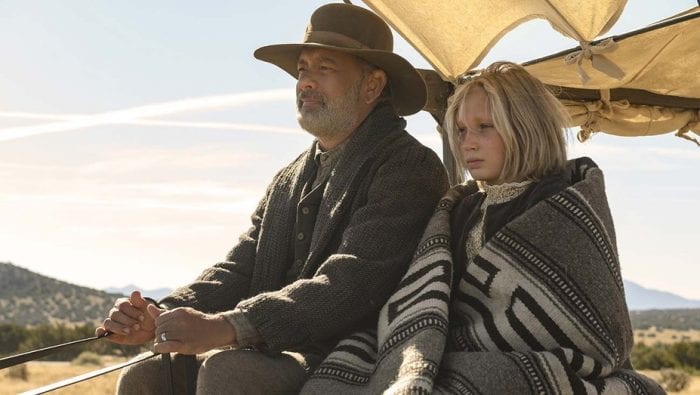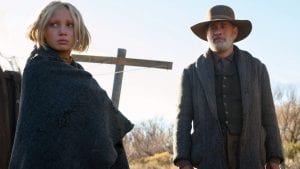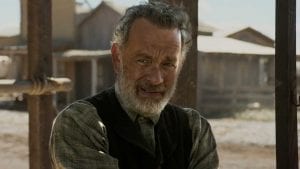Movie Review: Tom Hanks stars in post-Civil War drama ‘News of the World’

Reviewed by Jeffrey Sanzel
Set in 1870, Paulette Jiles’s 2016 novel News of the World is the story of a ten-year-old girl released after four years in captivity. Kiowa raiders had murdered her family, and she had been taken hostage, with the girl raised as one of the tribe. A freedman, entrusted with the girls’ return to her family, turns her over to his acquaintance, seventy-one-year-old Captain Jefferson Kyle Kidd. Thus begins Kidd’s journey of reuniting the girl with her only remaining relatives.
The screenplay, by the film’s director Paul Greengrass, in collaboration with Luke Davies, follows the basic premise. However, in the film, Kidd comes upon an overturned cart. The freedman charged in taking the girl back is hanging from a tree, a victim of a lynching in the still roiling post-Civil War Texas. Kidd attempts to shelter the girl with an army comrade until the Bureau of Indian Affairs representative can deal with the situation. After this fails, he takes it upon himself to see the girl home.

Photo by Bruce Talamon/Universal Pictures
In the novel, Kidd was a veteran of the War of 1812 and the Mexican-American War. One of the major changes from page to screen is that Kidd is now a guilt-ridden veteran of the Civil War, plagued by what he had seen and what he had done. This shift gives immediacy to the story as well as lowering Kidd’s age to in his 60s. In both book and film, Kidd travels from town to town giving live readings from newspapers, working for nickels and dimes.
The drive of the film is the unlikely pair finding common ground and understanding. The girl, whose given name is Johanna, was given the Kiowa name Cicada. She speaks no English and is almost feral. Having been orphaned twice, she is appropriately wild and untrusting. Throughout their time together, Kidd and Johanna strive to communicate, and a growing understanding arises. Ambivalence gradually gives way to a deep bond.
The narrative becomes a series of encounters, each one bringing them closer together. When three ex-Confederate soldiers offer to buy the girl, it sends the action into high gear. It is a chilling moment. (It would have been stronger had it not been present in every single promo for the film.) This horrific offer culminates with an extended shootout that is well-staged if a bit too long. What is revealed in this deadly encounter are the girl’s ingenuity and resourcefulness.
There are further confrontations, including a radical band of militia working to “cleanse” the country from “outsiders.” In addition to keeping the tension high, it shows Kidd’s more liberal and healing view of the world. This element, along with a handful of other moments, are more than a nod towards current political divides.
Tom Hanks is one of American cinema’s most beloved actors. His name is a guaranteed box office success and, most of the time, critical praise. His career is a roster of exceptional performances — Cast Away, Philadelphia, Forrest Gump, and many others. His recent portrayal of Fred Rogers in A Beautiful Day in the Neighborhood showed him at his best. Much like Jimmy Stewart, allowing Hanks’ persona to come through is what has made him an enduring star. It is the ability to see Hanks through whatever role he is playing that gives him uniqueness. Even as the child in a man’s body in the comedy Big, we were aware of Hanks, the actor, and embraced that awareness.
However, with Kidd, something more is required. As the damaged Confederate Civil War veteran, there is a sense of the dress-up about his performance. He is, as always, thoroughly engaging, but somehow it seems superficial. He is watchable but never quite transcendent. One must wonder if the producers, the director, and the writer didn’t just say “let Hanks be Hanks” and called it a day.

Part of the problem lies with the character itself. He is a struggling but inherently good man. He never once flinches from taking on the responsibility of returning this girl to her family. A more interesting choice would have been some vacillation or even resentment with the charge or that his primary interest had been fiscal rather than altruistic. This would have provided contrast and allowed for more arc and texture. Hanks is never less than very good, but he doesn’t achieve the level of greatness we have seen in so much of his work.
Helena Zengel, as Johanna, is remarkable. Both rough and insightful, willful and cowed, we watch her watch the world. With a tragic history, she is as wounded as Kidd. There is the spark of fire that never masks the deep pain. Greengrass has brought out a range of shades in her performance, enhancing a remarkable and burgeoning young talent.
Elizabeth Marvel is the hotel owner Mrs. Gannett who turns in a sensitive performance. She makes the most of her two brief scenes, reflecting both Kidd’s past and the world in which they live now.
The rest of the cast is not given a great deal to play. As Almay, who attempts to purchase the girl, Michael Angelo Covino represents pure evil. Likewise, Thomas Francis Murphy’s racist Mr. Farley makes a clear statement. Both do well in what are one-note roles.
In many ways, News of the World is a traditional western with all the standard expectations. It is episodic, stringing scene after scene, event after event. It is entertaining, but the whole is not greater than the sum of its parts. The journey is predictable, leading to a conclusion that mostly satisfies the need for a happy ending.
Rated PG-13, News of the World is now streaming on demand






